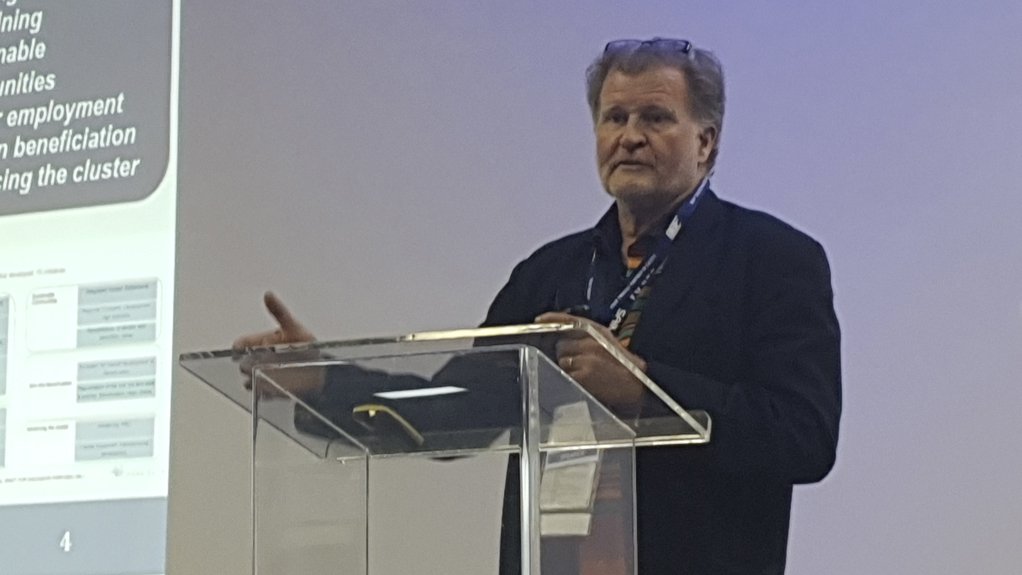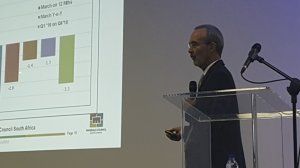Industrialisation to help South Africa’s mining cluster compete globally



Independent consultant Dr Paul Jourdan
Photo by Creamer Media's Simone Liedtke
Minerals Council South Africa chief economist Henk Langenhoven
Photo by Creamer Media's Simone Liedtke
JOHANNESBURG (miningweekly.com) – To ensure access to markets, at a scale which supports cost efficiency, local manufacturers and mining companies need to look beyond the country’s borders and grow their exports to Africa and the rest of the world, Minerals Council South Africa chief economist Henk Langenhoven said.
He further highlighted that companies with the right mindset could turn their supply chain into a source of sustainable competitive advantage through the implementation of Mining Charter III.
Considering that the local industry is too small to support the required economic scale needed for manufacturing, he highlighted that companies with the right mindset and priorities to turn their supply chain into a source of sustainable competitive advantage could do this through the implementation of Mining Charter III.
Speaking to delegates attending the South African Mining Supply Chain Conference and Strategy Workshop, on Wednesday, he said that, in complying with the charter, supply chain and mining companies could expect to achieve up to a 50% reduction in not just average maintenance spares levels, but also in the reduction of procurement costs and up to a 75% reduction in excess and obsolete inventory.
Independent consultant Dr Paul Jourdan further told delegates that advancing the mining cluster through the charter’s implementation, would maximise the local supply chain, create local mining equipment manufacturing capabilities and modernise South African mining, as well as revitalise South African mining research, development and innovation.
“[Through using] mining as a driver towards industrialisation, mechanisation and automation could be job neutral if the mining supply chain is developed locally,” Jourdan said, adding that original-equipment manufacturers would create additional jobs, as would all tiers of the supply chain.
The general consensus surrounding mechanization seems to be that it equals job losses, but Jourdan explained that through mechanisation, “it’s actually just removing [people] from a dangerous situation”.
He warned, however, that this had to be “carefully managed and required constant collaboration and partnerships between all stakeholders” for it to be effective.
Although the charter is “a great step forward”, Jourdan warned that it was “not a silver bullet in moving towards rebuilding the South African mining capital goods (MCG) sector”, and to displacing massive imports with exports.
To put this into context, Jourdan said the Southern African Development Community’s mining supply chain was dominated by imports. The region, he noted, imported between $3-billion and $6-billion worth of MCGs every year.
South Africa imported about $2-billion of those MCGs, which should be displaced with local content.
To double South Africa’s MCG output, Jourdan recommended key facilitation interventions, which included the introduction of funding for pre-prototype product development, developing more black-owned MCG firms, or even developing a “test mine” partnership.
STANDARDISED CODING SYSTEM
During his presentation, Langenhoven also noted that standardised coding and product identification systems in the mining supply chain had “enormous potential in terms of upgrading procurement practices to [enable the industry to] be better prepared for the Fourth Industrial Revolution”.
By implementing the system, supply chain companies could expect to see an enhancement of supply chain practices and cost savings, international exposure, domestic manufacturing expansion, as well as an enhancement of government systems and practices.
Collaboration, however, would be critical in making this a success, he added.
Department of Trade and Industry (DTI) project manager Abiel Mohlahlo said the department would be able to give an indication on when it would release the coding and product identification system within the next 18 months.
Developed to help industrialise South African mining and ensure compliance with the charter, Mohlahlo explained that the system would be used to facilitate the adoption of standardised production identification.
Under the system, the DTI is envisaging a National Product Catalogue to be used by mines as a database to look for products.
The system, while yet to be finalised, will be developed by the industry, for the industry.
Should the endeavour be successful, South Africa would be the first country globally to have such a system, Mohlahlo said.
The South African Mining Supply Chain Conference and Strategy Workshop was held on the sidelines of the inaugural Local Southern African Manufacturing Expo, in Johannesburg.
Comments
Press Office
Announcements
What's On
Subscribe to improve your user experience...
Option 1 (equivalent of R125 a month):
Receive a weekly copy of Creamer Media's Engineering News & Mining Weekly magazine
(print copy for those in South Africa and e-magazine for those outside of South Africa)
Receive daily email newsletters
Access to full search results
Access archive of magazine back copies
Access to Projects in Progress
Access to ONE Research Report of your choice in PDF format
Option 2 (equivalent of R375 a month):
All benefits from Option 1
PLUS
Access to Creamer Media's Research Channel Africa for ALL Research Reports, in PDF format, on various industrial and mining sectors
including Electricity; Water; Energy Transition; Hydrogen; Roads, Rail and Ports; Coal; Gold; Platinum; Battery Metals; etc.
Already a subscriber?
Forgotten your password?
Receive weekly copy of Creamer Media's Engineering News & Mining Weekly magazine (print copy for those in South Africa and e-magazine for those outside of South Africa)
➕
Recieve daily email newsletters
➕
Access to full search results
➕
Access archive of magazine back copies
➕
Access to Projects in Progress
➕
Access to ONE Research Report of your choice in PDF format
RESEARCH CHANNEL AFRICA
R4500 (equivalent of R375 a month)
SUBSCRIBEAll benefits from Option 1
➕
Access to Creamer Media's Research Channel Africa for ALL Research Reports on various industrial and mining sectors, in PDF format, including on:
Electricity
➕
Water
➕
Energy Transition
➕
Hydrogen
➕
Roads, Rail and Ports
➕
Coal
➕
Gold
➕
Platinum
➕
Battery Metals
➕
etc.
Receive all benefits from Option 1 or Option 2 delivered to numerous people at your company
➕
Multiple User names and Passwords for simultaneous log-ins
➕
Intranet integration access to all in your organisation



















